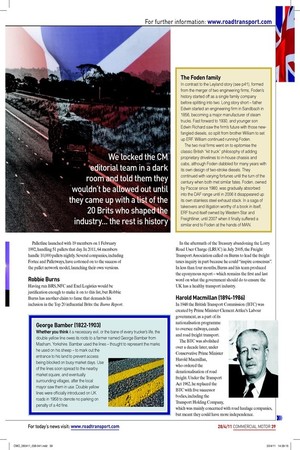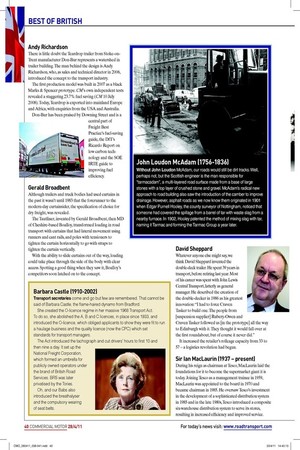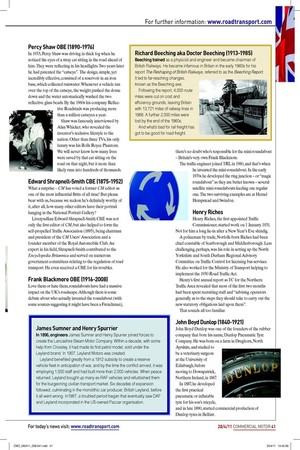Shaping Britain’s haulage industry
Page 31

Page 32

Page 33

Page 34

If you've noticed an error in this article please click here to report it so we can fix it.
And in no particular order...
Edward Stobart (1954-2011)
While it was Eddie Stobart who started the company (buying his frst truck – a Guy Invincible in 1960), it’s his son Edward who makes our list.
During his 30-plus years of involvement with Eddie Stobart, he had a massive impact – totally transforming the company from ledgling concern to one of the UK’s biggest and most instantly recognisable leets. He’s the one who decided to personalise the trucks with girls’ names and went on to form the hugely popular Eddie Stobart Fan Club.
But the reason we have chosen to include him in our Top 20 list of the most inluential Brits is quite simply because of the impact he had on the industry as a whole. We think it’s fair to say that he almost single-handedly revolutionised the UK haulage industry during the 1980s and 1990s.
He sold the company to his brother William and Andrew Tinkler in 2004, and died in March 2011, aged just 56.
Michael Heseltine (1933-present)
In February 1993, Leyland DAF went into voluntary receivership as its parent company DAF was forced to seek protection from creditors. Governments in Holland and Belgium stepped in to aid a restructuring and refnancing package for the truck manufacturer, but the president of the Board of Trade (the title the Secretary of State for Trade and Industry Michael Heseltine gave himself) refused to give Leyland DAF concrete support.
Heseltine’s notoriety in the British transport industry comes from his refusal to step in and save the biggest name in British truck manufacturing, which had, in one guise or another, been a manufacturer since 1895.
At the time, there was a real fear that Leyland DAF would close and pull out of the UK. British truck manufacturing fell into the hands of the Dutch and Americans as a result of his actions.
Bob Russett (1953-present)
Pallet networks, the multi-million-pound backbone of groupage movements in the UK, are the brainchild of Palletline founder Bob Russett.
He says the business concept was created when he was MD of Premier Transport, and met other hauliers in a bar to have a moan about how demanding customers were. The notion of replicating a parcel model where goods are distributed from a central hub was deliberated over several pints, and the pallet network model was born. Palletline launched with 19 members on 1 February 1992, handling 51 pallets that day. In 2011, 64 members handle 10,000 pallets nightly. Several companies, including Fortec and Palletways, have cottoned on to the success of the pallet network model, launching their own versions.
Robbie Burns
Having run BRS, NFC and Exel Logistics would be justiication enough to make it on to this list, but Robbie Burns has another claim to fame that demands his inclusion in the Top 20 inluential Brits: the Burns Report.
In the aftermath of the Treasury abandoning the Lorry Road User Charge (LRUC) in July 2005, the Freight Transport Association called on Burns to lead the freight taxes inquiry in part because he could “inspire consensus”. In less than four months, Burns and his team produced the eponymous report – which remains the irst and last word on what the government should do to ensure the UK has a healthy transport industry.
Harold Macmillan (1894-1986)
In 1948 the British Transport Commission (BTC) was created by Prime Minister Clement Attlee’s Labour government, as a part of its nationalisation programme to oversee railways, canals and road freight transport.
The BTC was abolished over a decade later, under Conservative Prime Minister Harold Macmillan, who ordered the denationalisation of road freight. Under the Transport Act 1962, he replaced the BTC with ive successor bodies, including the Transport Holding Company, which was mainly concerned with road haulage companies, but meant they could have more independence.
Andy Richardson
There is little doubt the Teardrop trailer from Stoke-onTrent manufacturer Don-Bur represents a watershed in trailer building. The man behind the design is Andy Richardson, who, as sales and technical director in 2006, introduced the concept to the transport industry.
The irst production model was built in 2007 as a black Marks & Spencer prototype. CM’s own independent tests revealed a staggering 23.7% fuel saving (CM 10 July 2008). Today, Teardrop is exported into mainland Europe and Africa, with enquiries from the USA and Australia.
Don-Bur has been praised by Downing Street and is a central part of Freight Best Practice’s fuel-saving guide, the DfT’s Ricardo Report on low carbon technology and the SOE IRTE guide to improving fuel eficiency.
Gerald Broadbent
Although trailers and truck bodies had used curtains in the past it wasn’t until 1983 that the forerunner to the modern-day curtainsider, the speciication of choice for dry freight, was revealed.
The Tautliner, invented by Gerald Broadbent, then MD of Cheshire-based Boalloy, transformed loading in road transport with curtains that had lateral movement using runners and cant rails, and poles with tensioners to tighten the curtain horizontally to go with straps to tighten the curtain vertically.
With the ability to slide curtains out of the way, loading could take place through the side of the body with clear access. Spotting a good thing when they saw it, Boalloy’s competitors soon latched on to the concept.
David Sheppard
Whatever anyone else might say, we think David Sheppard invented the double-deck trailer. He spent 39 years in transport, before retiring last year. Most of his career was spent with John Lewis Central Transport, latterly as general manager. He described the creation of the double-decker in 1986 as his greatest innovation: “I had to force Craven Tasker to build one. The people from [suspension supplier] Rubery-Owen and Craven Tasker followed us [in the prototype] all the way to Edinburgh with it. They thought it would fall over at the irst roundabout, but of course it never did.” It increased the retailer’s rollcage capacity from 33 to 57 – a logistics revolution had begun.
Sir Ian MacLaurin (1937 – present)
During his reign as chairman at Tesco, MacLaurin laid the foundations for it to become the supermarket giant it is today. Joining Tesco as a management trainee in 1959, MacLaurin was appointed to the board in 1970 and became chairman in 1985. He oversaw Tesco’s investment in the development of a sophisticated distribution system in 1985 and in the late 1980s, Tesco introduced a composite six-warehouse distribution system to serve its stores, resulting in increased eficiency and improved service.
Percy Shaw OBE (1890-1976)
In 1933, Percy Shaw was driving in thick fog when he noticed the eyes of a stray cat sitting in the road ahead of him. They were relecting in his headlights. Two years later he had patented the “catseye”. The design, simple, yet incredibly effective, consisted of a reservoir in an iron base, which collected rainwater. Whenever a vehicle ran over the top of the catseye, the weight pushed the dome down and the water automatically washed the two relective glass beads. By the 1960s his company Relective Roadstuds was producing more than a million catseyes a year.
Shaw was famously interviewed by Alan Whicker, who revealed the inventor’s reclusive lifestyle to the nation. Other than three TVs, his only luxury was his Rolls Royce Phantom. We will never know how many lives were saved by that cat sitting on the road on that night, but it more than likely runs into hundreds of thousands.
Edward Shrapnell-Smith CBE (1875-1952)
What a surprise – CM has voted a former CM editor as one of the most inluential Brits of all time! But please bear with us, because we reckon he’s deinitely worthy of it, after all, how many other editors have their portrait hanging in the National Portrait Gallery?
Liverpudlian Edward Shrapnell-Smith CBE was not only the irst editor of CM, but also helped to form the self-propelled Trafic Association (1895), being chairman and president of the CM Users’ Association and a founder member of the Royal Automobile Club. An expert in his ield, Shrapnell-Smith contributed to the Encyclopedia Britannica and served on numerous government committees relating to the regulation of road transport. He even received a CBE for his troubles.
Frank Blackmore OBE (1916-2008)
Love them or hate them, roundabouts have had a massive impact on the UK’s roadscape. Although there is some debate about who actually invented the roundabout (with some sources suggesting it might have been a Frenchman), there’s no doubt who’s responsible for the mini-roundabout – Britain’s very own Frank Blackmore.
The trafic engineer joined TRL in 1960, and that’s when he invented the mini-roundabout. In the early 1970s he developed the ring junction – or “magic roundabout” as they are better known – several satellite mini-roundabouts feeding one regular one. The two surviving examples are at Hemel Hempstead and Swindon.
Henry Riches
Henry Riches, the irst appointed Trafic Commissioner, started work on 1 January 1931. Not for him a long lie-in after a New Year’s Eve shindig.
A policeman by trade, Norfolk-born Riches had been chief constable of Scarborough and Middlesborough. Less challenging, perhaps, was his role in setting up the North Yorkshire and South Durham Regional Advisory Committee on Trafic Control for licensing bus services. He also worked for the Ministry of Transport helping to implement the 1930 Road Trafic Act.
Henry’s irst annual report as TC for the Northern Trafic Area revealed that most of the irst two months had been spent recruiting staff and “advising operators generally as to the steps they should take to carry out the new statutory obligations laid upon them”.
That sounds all too familiar.
John Boyd Dunlop (1840-1921)
John Boyd Dunlop was one of the founders of the rubber company that bore his name, Dunlop Pneumatic Tyre Company. He was born on a farm in Dreghorn, North Ayrshire, and studied to be a veterinary surgeon at the University of Edinburgh, before moving to Downpatrick, Northern Ireland, in 1867.
In 1887, he developed the irst practical pneumatic or inlatable tyre for his son’s tricycle, and in late 1890, started commercial production of Dunlop tyres in Belfast.














































